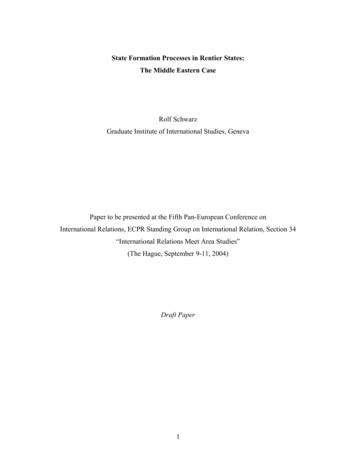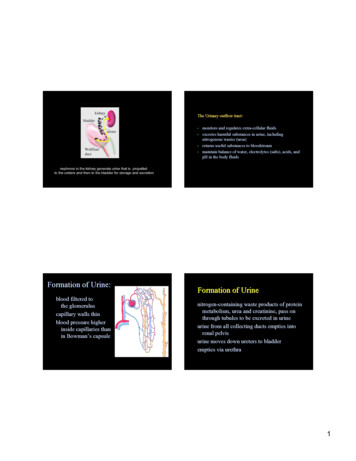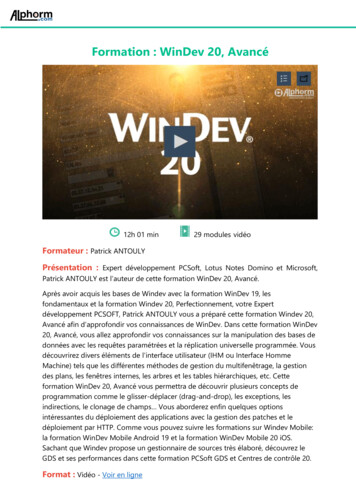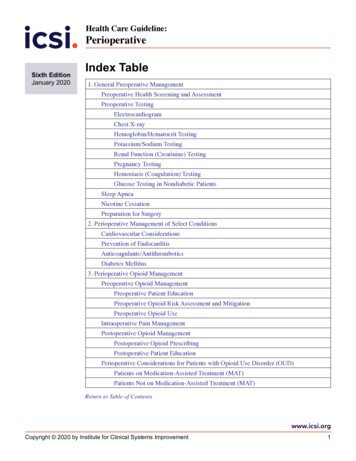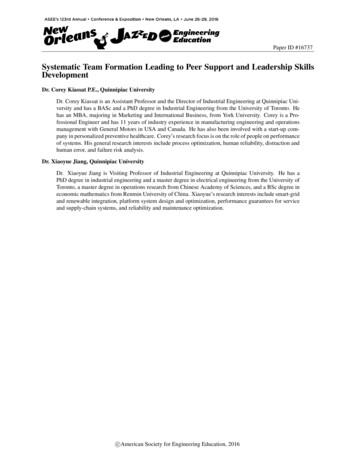
Transcription
Paper ID #16737Systematic Team Formation Leading to Peer Support and Leadership SkillsDevelopmentDr. Corey Kiassat P.E., Quinnipiac UniversityDr. Corey Kiassat is an Assistant Professor and the Director of Industrial Engineering at Quinnipiac University and has a BASc and a PhD degree in Industrial Engineering from the University of Toronto. Hehas an MBA, majoring in Marketing and International Business, from York University. Corey is a Professional Engineer and has 11 years of industry experience in manufacturing engineering and operationsmanagement with General Motors in USA and Canada. He has also been involved with a start-up company in personalized preventive healthcare. Corey’s research focus is on the role of people on performanceof systems. His general research interests include process optimization, human reliability, distraction andhuman error, and failure risk analysis.Dr. Xiaoyue Jiang, Quinnipiac UniversityDr. Xiaoyue Jiang is Visiting Professor of Industrial Engineering at Quinnipiac University. He has aPhD degree in industrial engineering and a master degree in electrical engineering from the University ofToronto, a master degree in operations research from Chinese Academy of Sciences, and a BSc degree ineconomic mathematics from Renmin University of China. Xiaoyue’s research interests include smart-gridand renewable integration, platform system design and optimization, performance guarantees for serviceand supply-chain systems, and reliability and maintenance optimization.c American Society for Engineering Education, 2016
Systematic Team Formation Leading to Peer Support andLeadership Skills Development1. IntroductionWithin a typical university environment, there are many courses that are taught in multiple sectionsand are multi-disciplinary. Within such settings, this paper aims to examine the role of teamformation on the following: 1) the learning of students, as measured by end-of-term grades,especially the weaker students; and 2) the quality of team leaders’ experiences. Two streams ofresearch in the literature are most relevant to this study: (1) leadership skill development inengineering education; (2) teaching-learning types and methods.1.1. Leadership Skill Development in Engineering EducationThere is a growing consensus on the importance of leadership skills in engineering practice andeducation in the US and worldwide1. From the viewpoint of Bonasso (2001), the focus on technicalskills can overlook the value of an engineering education as a foundation for becoming a successfulleader in many activities that benefit society2.In “The Engineer of 2020. Visions of Engineering in the New Century,” The National Academyof Engineering included leadership in their recommended attributes of the engineer and suggeststhat practice of leadership would grow in proportions as their careers advance3. Graham (2009)showed that leadership education is still a relatively new and under-resourced field4. Ahn et al.(2014) suggest that one of the reasons for the disproportion in leadership education lies in theshortage of research5.Leadership can be generally thought of as the combination of the following skills: management,team building, and creativity6. Wilding et al. (2012) attempt to arrive at a working definition ofleadership specifically for engineering education purposes by conducting and analyzing surveyswith a group of professional and industrial leaders on their Industrial Advisory Board7. A list of12 leadership traits is identified which encompasses principles of management of self, interactionswith others, and organizational effectiveness. In particular, these traits include “(3) Takes initiativerather than waits for assignments”; “(4) Follows as well as leads”; “(7) Receives criticism andmakes changes where appropriate”; “(8) Demonstrates a good attitude on life and is pleasant to
work with”; “(9) Is an effective communicator, including being a good listener”; “(10) Giveshonest feedback to others and helps them succeed in their responsibilities”; “(12) Is culturallysensitive and works effectively with people from diverse backgrounds”. Notable in this list is theprominence of teamwork skills. Many leadership skills are equally well and commonly labeledteamwork skills.A more formal empirical study on definition and assessment of leadership traits was documentedin Ahn et al. (2014)5. Results confirm that engineering leadership is similar to leadership as definedin business and organizational management and the leadership traits identified in the study alignwith those found in traditional leadership literature. For example, being proactive, motivated, andcourageous and having a vision and common goal are mentioned by Farr et al. (1997) 8 and Halland Seibert (1992) 9.It is also worthy of noting that these traits echo two of the non-technical ABET Student Outcomesa-k10: (d) “an ability to function on multidisciplinary teams”, and (g) “an ability to communicateeffectively”. While the general framework of team-based learning we are to adopt in this studynaturally reflects outcome (g), we explicitly structure the team formation according to outcome(d), i.e. enforcing a multidisciplinary team composition.1.2. Team-Based LearningIt becomes clearer based on the previous discussion that leadership skills (traits) are presented invarious forms of teamwork skills. It is thus no coincidence that we observe a growing practice andresearch on team-based pedagogy in engineering education. As suggested in Michaelsen et al.(2014)11, Team-Based Learning (TBL) 12-16 has proven to be a practical and effective strategy foraddressing these challenges and transforming our classrooms into a more enjoyable experience forteachers and students alike.Four foundational practices were also identified as essential for implementing TBL12-16: 1)strategically forming permanent teams (5-7 members per team), 2) ensuring student familiaritywith course content by utilizing a Readiness Assurance Process, 3) developing students’ criticalthinking skills by using carefully-designed, in-class activities and assignments and, 4) creating andadministering a peer assessment and feedback system. It was also suggested that the key to asuccessful team formation and management is (i) to ensure each group contains members of
diverse points of view and to minimize potential disruptions from cohesive subgroups such as preexisting friendships; and (ii) the team must remain stable over a long enough period for the teamdevelopment.In comparison, a cooperative-learning (CL) setting involves smaller groups (2-4 members) andruns non-permanent teams. Most CL tasks are structured to be completed within one class period,and can be handled by groups with 2-4 members. Smaller groups are both more efficient and moreeffective than larger groups in dealing with small-scaled tasks and projects. For a thoroughcomparative study on various types of learning in small groups, which include collaborativelearning, cooperative learning and problem-based learning, see Davidson and Major (2014) 17.We adopt a mixture of team-based and cooperative learning strategies to best suit our pedagogicalneeds. In particular, we adopt permanent team (a TBL feature) with 3-4 members each team (a CLfeature), and design experiments to test the multidisciplinary team structure against team formationwith likely cohesive subgroups.2. Project Goal and FrameworkThe design and implementation of an experiment in team formation is proposed in multiplesections of an Engineering Economic Analysis course with a high content of teamwork. In thetreatment group, the students are placed in teams based on academic ability. Each team is balancedby having a member from each of the “Great” (G), “Above Average” (AA), “Average” (A), and“Below Average” (BA) category. Each team is also formed to be multidisciplinary, to include atleast two engineering disciplines, out of the four disciplines offered at Quinnipiac University. Inthe control group, the students form their own teams. Team formation in the Control group willmost likely be based on previous familiarity of being in same courses in the past, likely as a resultof being in the same engineering discipline.The primary hypothesis is that class average in the treatment group will be higher. This isespecially true for the BA and A students who will have easy access to stronger team members instudy groups or for additional support. The secondary hypothesis is that the team leaders in thetreatment group will gain more skills in leadership, motivation, and conflict resolution as the teammembers have little to no prior knowledge about each other.
The proposed Engineering Economic Analysis course is one of only three engineering coursesduring the entire engineering curriculum at Quinnipiac University that is common to all fourengineering disciplines offered. Among the three common courses, it is the only one with atechnical content, requiring analytical work and problem solving. The importance of EngineeringEconomics in Engineering Curricula has been carefully examined in literature, see e.g. Zoghi(2015)18, and the cross-disciplinary nature of the classes were recognized and utilized in teachingpractice through team-based (Martinazzi, 1998)19 and project-based (LeBlanc and Boulanger,2014)20 methods. Commonality across the engineering programs ensures a large class size andmultiple sections. Having multiple sections, and a sufficient sample size in each section, providesthe opportunity for control and treatment groups within a design of experiment framework, leadingto statistically significant conclusions. A comparative study between multiple sections in particularbetween traditional and online delivery was reported in Wilck and Kauffmann (2013) 21.This course is scheduled for engineering sophomores (and selected freshmen) instead of seniorsas documented in some literature2. We believe it is advantageous to start learning and sharpeningteamwork and leadership skills as earlier as possible and engineering economics serves as a greatplatform. Such a belief, has been noted a century ago by a renowned engineer John Harford 21 thatengineering and economics “help to develop the very valuable habit of thinking in terms of groupsrather than of individuals”, where the direct connection between engineering economics andteam/group thinking is explicitly recognized and valued.At the time of writing this manuscript, the course is underway. Therefore, throughout thismanuscript, the design process, the course framework, and the proposed analysis are described indetail while the results are discussed based on instructor observations and graded material thus far.3. Design and AnalysisWhen it comes to curricular assessment, this particular course is used for formative assessment ofseveral ABET outcomes, including (d), “an ability to function on multidisciplinary teams”, and(g), “an ability to communicate effectively”, which as discussed above, can be interpreted asteamwork and/or leadership skills. As such, a great emphasis is placed on teamwork andcommunication skills. There are grading elements incorporated within the syllabus to reflect this.A large portion (26%) of the students’ end-of-term grade is team-based, consisting of the
following: (i) case study analyses and presentations, (ii) problem solving sessions for the class,and (iii) a project.(i)For case studies, the student teams are assigned an end-of-chapter case study from thetext book. The team spends 15 to 20 minutes in front of the class to present the case,their assumptions, and their analysis in answering the case questions.(ii)After every two chapters covered from the text book, there is a problem-solving sessionto ensure students are keeping up with the material. In these sessions, all the studentsin the class are expected to have attempted the assigned end-of-chapter problems ontheir own. However, one student team is assigned to take over the class and solve (andexplain) any questions that any student in class has difficulty with. Such anarrangement facilitates the notion of “students teaching the students” as quoted inMartinazzi (1998)19.(iii)The final element of the team-based grade is a project. Each team does a projectmanagement activity and perform a team presentation on their analysis of this activity.For all graded team-based components, CATME surveys are used for fair assessment of theindividual students’ roles. CATME is a short, web-based survey that collects and analyzes selfand peer-evaluation feedback. A behaviorally-anchored rating scale is utilized to assesscontributions of each team member in five areas based on the team effectiveness literature (Ohlandet al., (2012)23. The grade for each team-based component is multiplied by the CATME factor foreach student and that is the score entered for the student. As such, if a student does not pull his/herweight, s/he is penalized by the rest of the team and gets a lower grade than the rest of the teammembers. Conversely, if a student goes above and beyond the norm, s/he is recognized by theteammates and gets a higher grade than the original team score.It should be noted that another component of the course, Problem Sets, account for 18% of thefinal grade. The four problem sets are submitted on an individual basis. However, the members ofthe team with the highest average each receive a bonus point. This serves to encourage the teammembers to work with each other. In well-functioning teams, the strong members have anincentive to help the weaker members and the weaker ones have easy access to guidance.
There are two instructors for the three sections. Instructor 1, Section 1, is designated to be a controlgroup, consisting of 16 students, placed in four teams of four. Instructor 1, section 2, is designatedto be a treatment group, consisting of 14 students, placed in two teams of three and two teams offour. Instructor 2 only has a treatment group, consisting of 21 students, placed in four teams offour and one team of five. Data from Instructor 2 will complement the treatment group of Instructor1. As the project was being designed, we wanted to minimize the effect of having two differentinstructors. As such, we assigned Instructor 1 to have both a control group as well as a treatmentgroup, as opposed to having two control groups and leaving the treatment group to Instructor 2.Given the fact that Instructor 2 has a complementary section of the treatment group, adding to thesample size of the treatment group, we made the larger of the two sections of Instructor 1 to be thecontrol group.The two instructors use the same teaching material and follow the same teaching methods. Everyattempt is made to stay as consistent as possible across the three sections. The 75-minute class isconducted twice-a-week for 14 weeks and the two instructors compare notes before and after eachclass. The same text book is used and the cases, end-of-chapter problems, problem sets, midtermtest, and final exam are common to the three sections.Students have randomly selected any of the three sections based on time slots fitting their schedule.Prior to the start of term, the full class roster for all three sections was shared with an instructorfrom each of the four engineering programs for the purpose of categorizing students into G, AA,A, and BA. The discipline instructors who were chosen were those who have had direct contactwith the sophomore students and have taught them at least one discipline-specific course. As aresult, they were able to assess the students’ academic ability and to make an educated decision onwhich of the four categories each student can be placed in. Once the categorization of the studentswas complete, teams of four were made by the instructors in the two treatment groups to includea student from each of the four categories, G, AA, A, and BA, in order to have balanced teams.Another constraint the instructors used when forming the teams was to include at least twoengineering disciplines in each team. In sections 2 and 3, all teams have representation from atleast two engineering disciplines. In the control group, the students were asked to form their ownteams; the student categorization and their disciplines are noted by the instructor after the fact. Thenoting of these facts is solely for the purposes of the experiment, and the follow-up analyses, and
has no bearing on the team formation. In the control group, the four teams that were formed by thestudents are actually all multidisciplinary and include members from at least two engineeringdisciplines.At the completion of the semester, three comparisons will be made between the student grades inthe control and treatment groups. The first two comparisons are closely-related and they are theoverall class average grade as well as the average grade for the BA and A students. We hypothesizethat the overall average grade in the treatment group will be higher because the average grade forthe BA and A students will be higher. Those students who are categorized to be BA or A now haveaccess to two other students who are G or AA. Team-based learning will aid in their learningprocess as the weaker students work closely with strong students and can seek help when they runinto difficulties. We expect the average grade for the G and AA students to remain unchangedwhen comparing the control and treatment groups. The third comparison is the grade variationwithin the control and the treatment groups. Because we expect the average grade for the BA andA students to be higher (while the average grade for the G and AA students to remain the same),the range and standard deviation across the treatment group teams is expected to be smaller thanin the control group teams.Thus far in the course, there have been several graded elements, worth 55%. These two are a teamproject, three individual problem sets, the presentation of the team’s analysis of a case study, andthe midterm test. For the team project, a CATME survey was posted for the students. The resultsfrom the team project, the CATME survey, the first three problem sets, a case study analysis, andthe midterm test are displayed in Tables 1, 2, 3, 4, and 5 respectively. The results are still at thepreliminary stage and statistical analysis do not result in significant differences. However, thegeneral trends are in-line with our stated hypotheses; in all cases, the grade is higher in thetreatment group. In the case of the CATME results (Table 2), it should be noted that a smallerdeviation is desirable as it indicates more of an equal workload, and therefore peer satisfaction,across the team.
Table 1: Comparison of team project grades between control and treatment groupsSection 1 – ControlSections 2 and 3 combined TreatmentSample 16.98Standard DeviationTable 2: Comparison of student feedback on team dynamics during project workSection 1 - ControlSection 2 and 3 combined TreatmentAverage standard deviation for all teams0.040.034Table 3: Grade comparison of first three problem sets, control and treatment groupsSection 1 – ControlSections 2 and 3 combined TreatmentSample sizeAverageStandard Deviation4610390.65%92.36%1.933.04Table 4: Grade comparison of case study analysisSection 1 – ControlSections 2 and 3 combined TreatmentSample sizeAverageStandard Deviation122393.67%96.78%1.251.61
Table 5: Grade comparison of midterm test, control and treatment groupsSection 1 – ControlSections 2 and 3 combined TreatmentSample sizeAverageStandard Deviation163567.81%70.86%8.339.41Regardless of the process for forming the teams, selecting the team leader role is left to the studentteams. At the start of term, the two instructors ask their respective students to have team rules andto select a team leader. This role should rotate every three weeks to provide everyone with a chanceto experience the leadership position. At the end of the term, each student will individually submita reflection that discusses this experience. They will also individually complete a short survey,consisting of a number of close-ended questions with answers on a Likert scale for the purposesof evaluating their experience and learning. This reflection contributes to 4% of the studentsoverall grade at the end of the term. Using the survey questions, a comparison will be madebetween the team leaders in the control and treatment groups. Our hypothesis is that the teamleaders in the control group will learn more as they have to play a larger role to facilitate teamtasks, act as a leader, motivate everyone, and resolve conflicts. This is mainly due to the fact thatthe team members do not know each other from before and have been put together by the instructor.The results of the survey will be used to test the hypothesis that team leaders in the treatment groupwill gain more skills in leadership, motivation, and conflict resolution. In addition to assessing thequality of learning that each student experiences when fulfilling the team leader role, the surveyalso needs to capture the possible foregone opportunity to work on a multidisciplinary team. If thestudents form their own teams, there is a high chance they do so based on prior familiarity witheach other. This is likely based on having had courses together which likely results from being inthe same discipline. As mentioned before, instructors form teams to be balanced andmultidisciplinary. But when the students form their own teams in the control group, neither one ofthese two criteria is used as a design parameter in team formation.
4. Future WorkA multi-section, sophomore-level, core course, common to all four disciplines of engineering atQuinnipiac University is used to run an experiment to test two hypotheses. There is significantemphasis on teamwork in the course and 26% of each student’s end-of-term grade is directlyaffected by their team members. In the design of this experiment, one of the three sections is thecontrol group and the students in this section are asked to form their own teams, with no inputfrom the instructor. The other two sections are the treatment group and the instructors form thestudent teams. Team formations in the treatment group are based on two criteria: 1) the academicquality of the students, pre-determined through consulting a faculty member who has had thestudent in a class before, and 2) the multidisciplinary nature of teams, by having representationsof at least two of the four engineering disciplines offered at Quinnipiac University. Regardless ofthe team formation process, the instructors have no input into team leader selection or team rules.Teams select their own leaders and this role rotates throughout the semester to ensure everyoneexperiences this responsibility.The primary hypothesis is that class average in the treatment group will be higher. This isespecially true for the A and BA students who will have easy access to stronger team members instudy groups or for additional support. The secondary hypothesis is that the team leaders in thetreatment group will gain more skills in leadership, motivation, and conflict resolution as the teammembers have little to no prior knowledge about each other.This course is ongoing and the results are not finalized. However, the preliminary analysis ispromising and the first hypothesis about the treatment group having a higher class average thanthe control group currently holds. Once the hypotheses are tested at the end of the semester, andassuming they both hold, other classes with a high level of teamwork can follow suit to formbalanced and multidisciplinary teams. This requires an additional burden for the course instructoras s/he has to reach out to other instructors and gain insight on each student’s academic ability.However, after this information is used to systematically form teams, the learning experience ofthe students is enhanced and goes beyond the course-specific, theoretical knowledge of the course.Students gain maturity as they learn about leadership, motivation, and conflict resolution. Theconcepts described can be easily transferred to courses with a high level of teamwork, whether itis an engineering course or in any other discipline.
AcknowledgementThe authors wish to express gratitude for receiving the Scholarship of Teaching and Learning grantat Quinnipiac University. In addition, the authors appreciate the constructive comments from theeditor and the anonymous reviewer.References1.Siller, T. J., Rosales, A., Haines, J., and Benally, A. (2009). Development of Undergraduate Students’Professional Skills. Journal of Professional Issues in Engineering Education & Practice, 135 (3), 102-108.2.Bonasso, S. G. (2001). Engineering, leadership, and integral philosophy. J. Professional Issues EngineeringEducation and Practice, 127 (1), 17–25.3.NAE (2004). The Engineer of 2020, Visions of Engineering in the New Century, National Academy ofEngineering. 020-visions-of-engineering-in-the-new.4.Graham, R. (2009). Educating tomorrow’s engineering leaders. Materials Today, 12 (9), 6.5.Ahn, B., Cox, M.F., London, J., Cekic, O., and Zhu, J. (2014). Creating an Instrument to Measure Leadership,Change, and Synthesis in Engineering Undergraduates, Journal of Engineering Education, 103 (1), 115–1366.Harper, G.R., and Sullivan. M.V. (1996). Hope is not a method: What business leaders can learn fromAmerica's army. Broadway Books, New York.7.Wilding, W.V., Knotts, T.A. IV, and Pitt, W.G. (2012). AC 2012-4462: Developing and AssessingLeadership in Engineering Students. age 25: 1.8.Farr, J.V., Walesh, S.G., and Forsythe, G.B.(1997). Leadership development for engineering managers.Journal of Management in Engineering, 13(4), 38–41. doi: 10.1061/(ASCE)0742-597X(1997)13:4(38)9.Hall, D.T., and Seibert, K.W. (1992). Strategic management development: Linking organizational strategysuccession planning, and managerial learning. In Montross, D.H. (Ed) and Shinkman, C.J. (Ed) (1992).Career development: Theory and practice. Springfield, IL, England: Charles C Thomas, Publisher.10. ABET. (2016). Criteria for accrediting engineering programs: Effective for review during the 2016–2017accreditation cycle. Retrieved from s-2016-2017/11. Michaelsen, L.K., Davidson, N., and Major, C.H. (2014). Team-based learning practices and principles incomparison with cooperative learning and problem-based learning. Journal on Excellence in CollegeTeaching, 25(3&4), 57-8412. Michaelsen, L.K., Knight, A.B., and Fink, L.D. (2004). Team-based learning: A transformative use of smallgroups in higher education. Sterling, VA: Stylus.13. Michaelsen, L.K., Parmelee, D.X., McMahon, K. and Levine, R.E. (2007). Team-based learning for healthprofessions education: A guide to using small groups for improving learning. Sterling, VA: Stylus.
14. Michaelsen, L.K., Sweet, M. and Parmelee (2008). Team-based learning: small group learning’s next bigstep. New Directions for Teaching and Learning, 116. San Francisco: Jossey-Bass.15. Sweet, M. and Michaelsen, L.K. (2012) Team-based learning in the social sciences and humanities: Groupwork that works to generate critical thinking and engagement. Sterling, VA: Stylus.16. Sibley, J. and Ostafichuk, P. Teamwork that works: guide to implementing team-based learning. Sterling,VA: Stylus.17.Davidson, N., and Major, C. H. (2014). Boundary crossings: Cooperative learning, collaborative learning,and problem-based learning. Journal on Excellence in College Teaching, 25(3&4), 7-55.18. Zoghi, S. (2015). Engineering Economics and Its Role in the Engineering Curricula. Paper presented at 2015ASEE Annual Conference and Exposition, Seattle, Washington.19. Martinazzi, R. (1998), Implementing Student Learning Teams in Engineering Economics. Paper presented at1998 Annual Conference, Seattle, Washington.20. LeBlanc, H.J. and Boulanger, B.O. (2014). A Cross-Discipline, Project-Based Approach to TeachingEngineering Economy; 121 ASEE Annual Conference and Exposition. Indianapolis, IN, June 2014.21. Wilck, J. H., & Kauffmann, P. J. (2013). A Comparative Review of Two Engineering Economics Sections:One Traditional and One Online. Paper presented at 2013 ASEE Annual Conference, Atlanta, Georgia.22. Harford, J. F. (1917). The Relation of Engineering to Economics. Journal of Political Economy, 25(1), 5963.23. Ohland, M.W., Loughry, M.L., Woehr, D.J., Bullard, L.G., Felder, R.M., Finelli, C.J., Layton, R.A.,Pomeranz, H.R., and Schmucker, D.G. (2012). The Comprehensive Assessment of Team MemberEffectiveness: Development of a Behaviorally Anchored Rating Scale for Self- and Peer Evaluation.Academy of Management Learning & Education, 11(4), 609-630.
Dr. Corey Kiassat P.E., Quinnipiac University Dr. Corey Kiassat is an Assistant Professor and the Director of Industrial Engineering at Quinnipiac Uni-versity and has a BASc and a PhD degree in Industrial Engineering from the University of Toronto. He has an MBA, majoring in Marketing and International Business, from York University. Corey is a .
